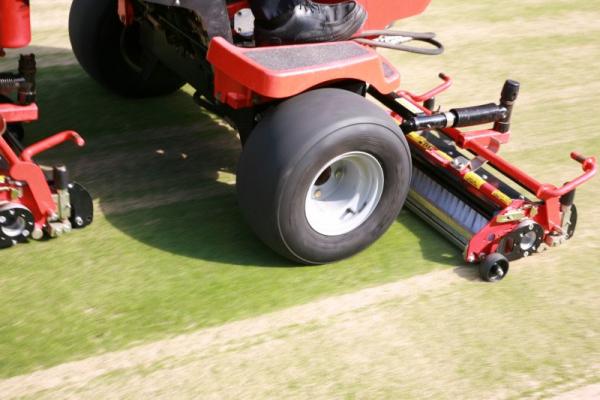Grooming greens through brushing or rolling, or both, have been reliable methods for producing improved playing conditions and increased putting speeds. When done together, they also help incorporate topdressing into the turf, greatly reducing the amount of sand picked up during mowing.
 Newer high-shoot density grasses, such as ultradwarf Bermudagrasses and even newer creeping bentgrass varieties, can make it difficult to work sand into the green where it can help promote the breakdown of organic matter, according to Karl Danneberger, Ph.D., at Ohio State University.
Newer high-shoot density grasses, such as ultradwarf Bermudagrasses and even newer creeping bentgrass varieties, can make it difficult to work sand into the green where it can help promote the breakdown of organic matter, according to Karl Danneberger, Ph.D., at Ohio State University."Sand topdressing helps control/dilute organic matter accumulation on putting greens," Danneberger wrote. "The popularity of high shoot density creeping bentgrass and Bermudagrass ultradwarf varieties make the incorporation of topdressing into greens difficult. The inability to incorporate (sand) can result in much of the topdressing being removed by mowing. Additionally, mower blades loose their sharpness resulting in poor mowing quality."
Danneberger cited a seminal study in his writings.
According to research conducted at the University of Tennessee, a regimen of brushing followed by rolling resulted in virtually no mower pick up. The amount of sand picked up during mowing after brushing then rolling on a TifEagle plot was not statistically different than that picked up from an untreated control plot that received no additional sand throughout the duration of the study.
Conversely, rolling alone after topdressing resulted in an average of 10 percent of sand lost during mowing. The sand mix was 15.6 percent coarse, 73 percent medium and 11.4 percent fine.
"When we rolled only after topdressing, it was like putting marbles on a trampoline and jumping up and down on it," said John Sorochan, Ph.D., of the University of Tennessee. "The smaller stuff got in, but we picked up almost all of the coarse and very coarse grains. I think one time we picked up 30 to 35 percent of the sand. Just think of the wear and tear. The mechanic would be screaming at you.
...one time we picked up 30 to 35 percent of the sand. Just think of the wear and tear. The mechanic would be screaming at you." -- John Sorochan
"When we brushed and followed with a roller, we never picked up more than 2 to 3 percent. You couldn't tell the difference between that plot and the control plot that didn't get any sand."
The news has been a boon to superintendents, especially those in the transition zone who have converted from cool-season grass to an ultradwarf Bermuda in recent years, said Sorochan.
That is especially true of low-budget facilities that made the conversion because they thought the Bermuda would require less maintenance than cool-season grass. That hasn't been the case necessarily, says Sorochan.
The constant need for fine-particle sand to promote organic matter management can make managing ultradwarf greens nearly as time-consuming and costly as growing cool-season turf.
"It's not always easy to get fine sand, and it's not cheap when you do get," Sorochan said. "Now you don't have to."
The ability to keep more sand in the profile over two years of the study helped dilute thatch buildup and resulted in a firmer surface.
Researchers used a Clegg soil impact tester to determine surface hardness. Results of the study indicated that brushing followed by rolling produced the hardest surface, following by brushing alone. Both were much firmer than the untreated control plot, which proved to be more firm than the plot subjected to rolling alone, but the difference was not statistically different.
"It was rewarding," Sorochan said. "There was actually practical use for it that superintendents could utilize right away."

